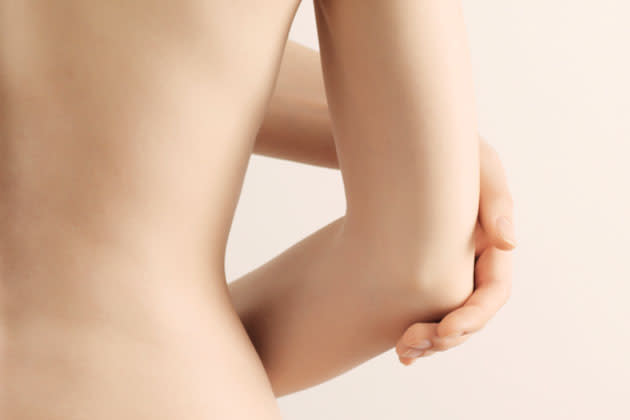Lighten Your Body's Dark Spots

Everyone has them, so there's no use denying you're sporting them, too: we're talking about dark areas on our skin, such as the elbows, knees, and armpits. Unless you're a walking Photoshopped version of yourself, chances are, you've groaned and moaned about what to do with your knees before you put on a miniskirt, or how you'll get by not raising your arms to reveal dark 'pits when wearing that cute halter top.
If you're one of many who are dead set on finding ways to lighten these "problem areas", it's good to know what causes these areas to go "dark" in the first place.
Sweat, friction, and melanin production
Our armpits produce sweat to cool down our body, and excessive sweat collects in the folds of our skin. Sometimes, this sweat doesn't completely dry out. This then produces uric acid, which can darken anything over time.
Our knees and elbows, on the other hand, are flexed more than a hundred times a day and rub against our clothes constantly. Just imagine the wear and tear your knees take as they rub against your denim jeans, or when you kneel down. Or having to place your elbows on armchairs, tables, and other surfaces for support. With so much abuse, there's no wonder our elbows and knees can get so calloused and dry.
Another culprit for darkened skin areas is hyperpigmentation. This happens when the skin produces an excess of melanin, which is responsible for our skin color. Think of melanin as our skin's own built-in sunscreen, as it protects our skin from the sun's harmful UVA rays—so the more sun exposure you get, the more melanin your body produces (which explains why you tan at the beach).
While it shields us from the harmful rays of the sun to some extent, melanin also protects our skin from irritants by upping this production and forming a hard layer on the skin. This enables the particular skin area (in this case, your knees, elbows, and armpits) to take more wear and tear than the rest of the body.
What you can do
So how do you lighten these dark spots? For one, prevention.
If you shave your armpits, consider waxing instead. Shaving cuts hair just below the surface of the skin. The leftover hair below the surface can give the appearance of a dark stain. Also, consider switching deodorants. Some deodorants and antiperspirants contain harsh chemicals (usually in the form of fragrances) that can be irritating your skin.
As for your knees and elbows, try to be kinder to them. Moisturize them at night before going to bed, and try to avoid kneeling or resting your elbows on hard surfaces. It's also a good idea to slather on sunscreen on those areas—more melanin is produced when skin areas are exposed to the sun, so help out your skin by slathering on sunscreen with an SPF of 15 or more.
However, if you're serious about whitening your body's dark areas ASAP, pharmaceutical beauty products are for you.
Whitening beauty products may contain ingredients such as hydroquinone or alpha arbutin. Hydroquinone is the "standard" when it comes to whitening products—however, if used incorrectly, could lead to ochronosis, wherein one's skin gets even darker (even getting a gray tone) over time. Alpha arbutin, on the other hand, is a plant derivative and used on skin that's sensitive to hydroquinone. There's also a lesser chance of getting hyperpigmentiation with alpha arbutin.
Alpha arbutin and hydroquinone do the same thing: they inhibit the production of melanin in the skin, causing the skin to be even more sensitive to UVA and UVB rays. If you plan on using products with these chemicals, be sure to put on extra sunscreen before stepping out of the house.

